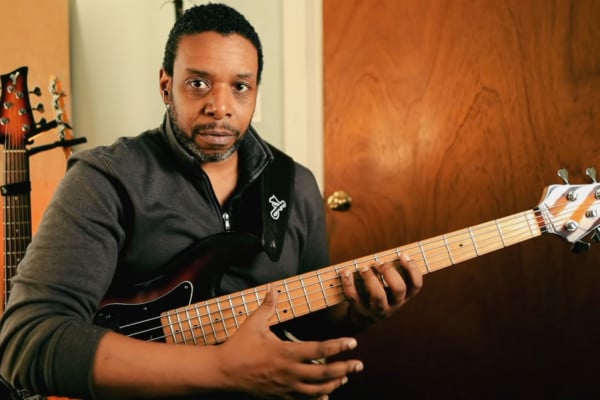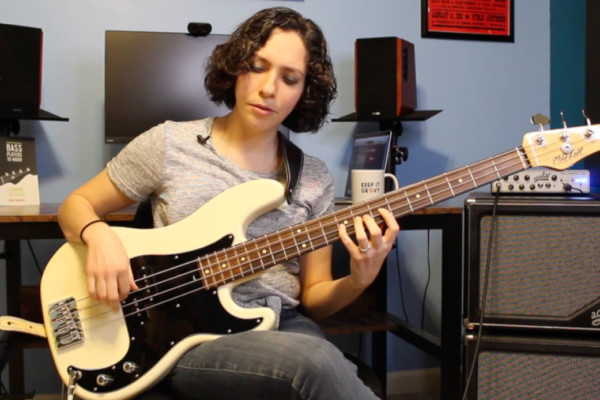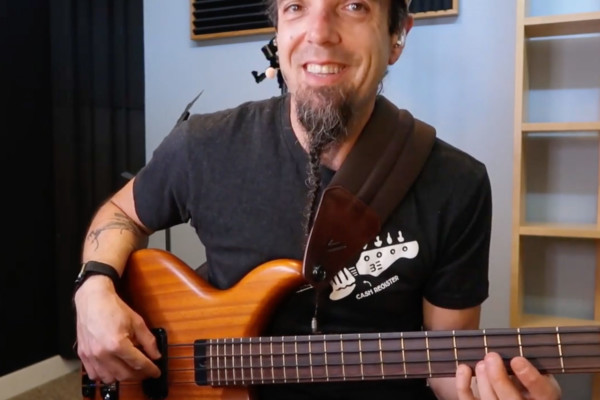Ask Damian Erskine: Theory and right hand technique
Q: Just wanted to ask you how can I get used to using the harmonized major and minor scales when soloing or using them when I’m playing a fill. I use the relative major or minor of the key I’m playing in regularly but I cant seem to get the other scale degree’s to work.
My second question is how can I improve my right hand speed. I should explain due to me having a mild physical disability I have less control over my right hand but I’ve been playing for almost 5 years now and I still cant play 16th notes properly. Help!!
A: Thanks for the questions! Regarding the use of major/minor scales from different degrees…
I am never thinking about a scale when I’m playing so much as thinking about the tonality, what notes are inherent to that tonality and what notes are near where I am on the neck.
I tend to set targets for myself while I’m improvising (for example: I may know that I’m coming up on a G-7 chord and so I’ll set a target of landing on the 9 (A) of the chord. I do this almost constantly while I’m soloing. The only time I’m NOT doing it is when I’m either:
a) very much in the zone and just using my ears
b) very much NOT in the zone and unable to formulate a musical thought.
I think what you may want to do is get comfortable with and fully explore how EVERY note of the scale SOUNDS against a given chord. This will help you to be able to think of other scale degrees to land on because you’ll know how they sound and not just that they are in the scale. Therefore, you’ll have a better sense of how they can be used.
Play a chord and have it repeating (however you can… use a looper, band in the box, sequencer, anything… just set up a repeating chord or short progression to practice over).
Now just be very patient and slowly experiment with different chord tones.
Play the major 7th on the bass over the chord. Do it in different registers (octaves) so you can hear how it sounds better up high that down low
Do this with every scale tone
Do this with EVERY NOTE (chromatic scale)
An important thing to realize is that:
THERE ARE NO WRONG NOTES, JUST BAD RESOLUTIONS
…meaning, we’re all typically scared of “wrong notes” and therefore we don’t know how to incorporate the use of tension effectively. Notes outside of the tonality are very effective if you can learn to resolve them or use them in the context of a harmonic pattern, etc…
What we really just need to do is get comfortable with ALL of the notes, know what they are and how they interact with a given chord or set of changes. Practice this one note at a time over every different kind of chord you can think of or play… this will expand your ability to hear them…
Regarding technique:
I DO have a response to a question on how to develop facility (in the archives for this column). However, you say you have a mild physical disability. Without knowing what it is or how it affects you (or without me being a doctor), I hesitate to give much in the way of advice beyond my previous explanation of how one develops speed and articulation. I will say this (as one who may inherit a genetic disorder that will affect my OWN motor functions in another decade or so):
There is always a way, you may just have to get creative. Bill Clements comes to mind… He’s a pretty phenomenal one-armed bassist! He took a situation which most would perceive to be final (like, one arm… definitely can’t play bass then) and, through creativity and passion figured a way around it. He is able to tap some pretty amazing lines with just his fretting hand and figured out how to set-up his bass and mute the strings, etc… to make it work.
If your disability is only affecting the plucking hand, maybe you could incorporate more hammered notes into your lines, for example… Experimentation will be the key. There’s almost always a way. Just take some time and try new things. If your disability simply prevents you from doing something specific, see it as an opportunity to come up with something ELSE!
Have a question for Damian? Ask him!
Check out more Ask Damian Erskine columns
Have a question for Damian Erskine? Send it to [email protected]. Check out Damian’s instructional books, Right Hand Drive and The Improviser’s Path.




[…] Damian Erskine 2009-08-20 02:30:02 Here is the original: Ask Damian Erskine: Theory and right hand technique […]
Damian, your article is inspiring and perfectly timed.
“THERE ARE NO WRONG NOTES, JUST BAD RESOLUTIONS.”
I consider myself an “advanced” player, but this advice alone will keep me busy for years. There's that next level, “expert” that I next want to achieve. Thanks for showing the way!
Awesome.
Thats my favorite line in there as well!
Hi Damian, Can you suggest any exercises to help me to internalize the notion of targets when playing over chord changes and work them into my playing ? Thanks so much! M2
Hi Damian, Can you suggest any exercises to help me to internalize the notion of targets when playing over chord changes and work them into my playing ? Thanks so much! M2